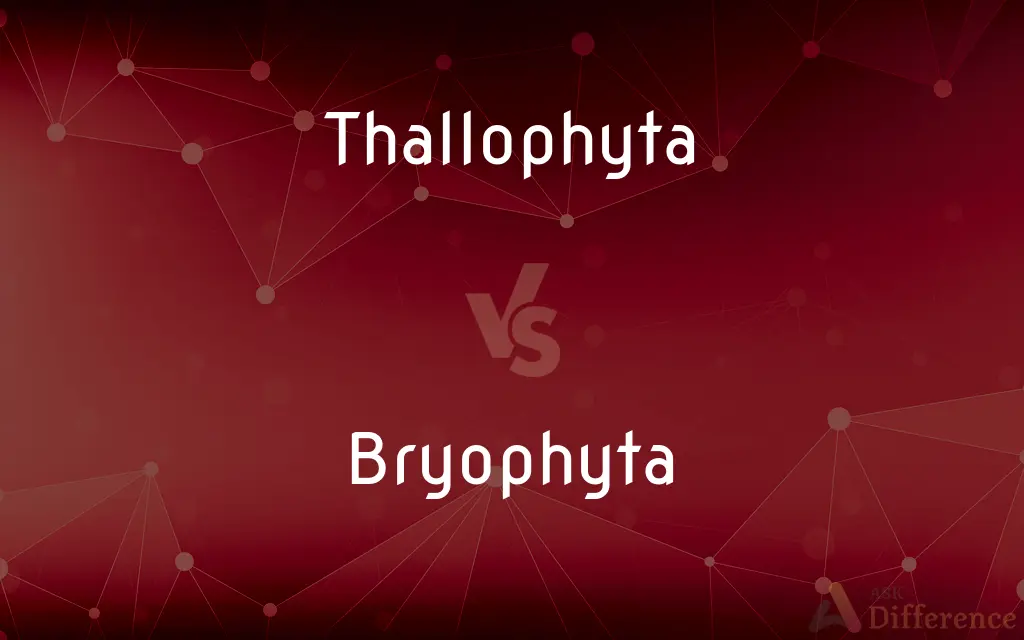Thallophyta vs. Bryophyta — What's the Difference?
By Fiza Rafique & Maham Liaqat — Updated on May 10, 2024
Thallophyta are simple, non-vascular plants with undifferentiated bodies, typically including algae and fungi; Bryophyta comprises non-vascular mosses with more complex structures, like leaves and roots.

Difference Between Thallophyta and Bryophyta
Table of Contents
ADVERTISEMENT
Key Differences
Thallophyta refers to a now obsolete classification that once included simple plants like algae and fungi, characterized by their thallus-like structure where there is no differentiation into roots, stems, or leaves. Bryophyta, commonly known as mosses, represents a division of non-vascular land plants that are more complex, featuring structures that resemble leaves and stems, and anchoring rhizoids instead of true roots.
Thallophytes generally thrive in moist or aquatic environments, using their simple body structures to absorb nutrients and water directly from their surroundings. In contrast, Bryophytes are primarily terrestrial and adapt to moist environments, using their rhizoids to anchor to surfaces and help absorb water.
While Thallophytes are mostly autotrophic, using photosynthesis to create their own food, some fungi within the group are heterotrophic, absorbing nutrients from organic material. Bryophytes are autotrophic, relying entirely on photosynthesis, which occurs across their leaf-like structures.
Reproduction in Thallophyta can vary widely, with some reproducing through fragmentation or spores, while others have complex reproductive cycles. Bryophytes generally reproduce both genders, with spores produced in sporangia, and via fragmentation.
Thallophytes like algae can form vast colonies that are crucial for aquatic ecosystems, providing oxygen and serving as a food source. Bryophytes play a key role in terrestrial ecosystems, helping in soil formation, moisture retention, and as bioindicators of environmental quality.
ADVERTISEMENT
Comparison Chart
Structure
Undifferentiated body (thallus)
Differentiated into stem- and leaf-like structures
Habitat
Mainly aquatic and moist areas
Primarily terrestrial, moist environments
Nutrient Absorption
Directly from surroundings
Through rhizoids
Photosynthesis
Present in autotrophic thallophytes
Present across all mosses
Reproduction
Varied, including reproduction
(Spores) and (fragmentation)
Ecological Role
Oxygen production, part of food chain
Soil formation, moisture retention
Compare with Definitions
Thallophyta
Includes both autotrophic and heterotrophic organisms.
While most algae are autotrophic, some thallophytic fungi are heterotrophic.
Bryophyta
Moss bodies are differentiated into structures resembling stems and leaves.
Mosses have simple leaves arranged around stem-like structures.
Thallophyta
Important in ecological nutrient cycling and as primary producers.
Algae contribute significantly to oxygen production in aquatic habitats.
Bryophyta
Reproduces using spores that are released from sporangia.
Moss spores are dispersed by the wind, facilitating widespread colonization.
Thallophyta
A group formerly used to classify lower plants such as algae and fungi based on their simple body structures.
Seaweeds, important components of marine ecosystems, belong to Thallophyta.
Bryophyta
A division of non-vascular plants that includes mosses.
Sphagnum, a type of moss, is crucial for creating bogs and storing carbon.
Thallophyta
Characterized by a lack of true roots, stems, or leaves.
The thallus of an alga absorbs nutrients directly from the water.
Bryophyta
Thrives in damp terrestrial environments.
Mosses often carpet forest floors where moisture is abundant.
Thallophyta
Found in a variety of environments, mainly aquatic.
Freshwater algae from Thallophyta often bloom in nutrient-rich conditions.
Bryophyta
Plays a role in preventing soil erosion and retaining moisture.
Bryophyta mosses are essential for maintaining soil structure in many ecosystems.
Thallophyta
Used only in former classifications: comprising what is now considered a heterogeneous assemblage of flowerless and seedless organisms: algae; bacteria; fungi; lichens
Bryophyta
See Cryptogamia.
Bryophyta
A division of nonflowering plants characterized by rhizoids rather than true roots and having little or no organized vascular tissue and showing alternation of generations between gamete-bearing forms and spore-bearing forms; comprises true mosses (Bryopsida) and liverworts (Hepaticopsida) and hornworts (Anthoceropsida)
Common Curiosities
What are the reproductive strategies of Thallophyta compared to Bryophyta?
Thallophyta may reproduce often through spores or fragmentation, while Bryophyta typically reproduce via spores and can also regenerate from fragments.
How do Thallophyta and Bryophyta differ in their habitats?
Thallophyta are mainly found in aquatic environments, whereas Bryophyta are mostly terrestrial, thriving in moist conditions.
What ecological roles do Thallophyta and Bryophyta play?
Thallophyta, such as algae, are crucial in aquatic food chains and oxygen production, while Bryophyta help in soil stabilization and moisture retention on land.
What structural adaptations help Thallophyta and Bryophyta in their respective habitats?
Thallophyta are adapted to their aquatic habitats with structures that allow direct absorption of nutrients from their surroundings, while Bryophyta have developed rhizoids that help them anchor to substrates and absorb water.
Are Thallophyta and Bryophyta important for human use?
Yes, both groups have significant uses. Thallophyta like algae are used in foods, biofuels, and pharmaceuticals. Bryophyta are used in gardening, as bioindicators for environmental health, and historically, even for medicinal purposes.
How do Thallophyta and Bryophyta contribute to their ecosystems?
Thallophyta, like algae, play a key role in aquatic ecosystems by producing oxygen and serving as a primary food source. Bryophyta, such as mosses, contribute to their ecosystems by aiding in soil formation and water retention, and providing habitats for microfauna.
What distinguishes Thallophyta from Bryophyta in terms of structure?
Thallophyta have a simple, undifferentiated thallus, while Bryophyta have more complex bodies with distinct, leaf-like structures.
What types of environments are necessary for the growth of Thallophyta and Bryophyta?
Thallophyta mainly require aquatic or extremely moist environments to thrive, while Bryophyta grow best in moist, terrestrial environments but not necessarily submerged in water.
What challenges do Thallophyta and Bryophyta face in their survival?
Thallophyta face challenges such as water pollution and habitat destruction, which can affect their growth and reproduction. Bryophyta are sensitive to air quality and water availability, making them vulnerable to environmental changes and habitat loss.
Can Thallophyta and Bryophyta be easily cultivated?
Thallophyta, such as certain algae, can be cultivated in controlled aquatic environments for commercial purposes. Bryophyta can also be cultivated, but they often require specific humidity and lighting conditions to mimic their natural moist habitats.
Can both Thallophyta and Bryophyta perform photosynthesis?
Yes, autotrophic Thallophyta and all Bryophyta perform photosynthesis, though the mechanisms and structures involved differ.
How does climate change impact Thallophyta and Bryophyta?
Climate change can lead to shifts in water temperature and chemistry that affect Thallophyta, potentially causing harmful algal blooms. For Bryophyta, changes in precipitation patterns and humidity can reduce their habitats and affect their growth.
What future research directions are being explored for Thallophyta and Bryophyta?
For Thallophyta, research focuses on maximizing their potential for biofuel production and exploring new pharmaceutical applications. For Bryophyta, research is often directed towards understanding their ability to combat soil erosion and their use in ecological restoration projects.
How do the reproductive structures of Thallophyta and Bryophyta differ?
Thallophyta often reproduce through simple structures that release spores directly into their environment. In contrast, Bryophyta develop more complex reproductive organs, such as sporangia on stalks, which elevate spores for wider dispersal.
What are the key biological differences between Thallophyta and Bryophyta?
Biologically, Thallophyta do not differentiate into true roots, stems, or leaves and can include autotrophic and heterotrophic organisms. Bryophyta are solely autotrophic and feature structures resembling leaves and stems but lack vascular tissue.
Share Your Discovery

Previous Comparison
Shredded vs. Grated
Next Comparison
Calibration vs. StandardizationAuthor Spotlight
Written by
Fiza RafiqueFiza Rafique is a skilled content writer at AskDifference.com, where she meticulously refines and enhances written pieces. Drawing from her vast editorial expertise, Fiza ensures clarity, accuracy, and precision in every article. Passionate about language, she continually seeks to elevate the quality of content for readers worldwide.
Co-written by
Maham Liaqat












































